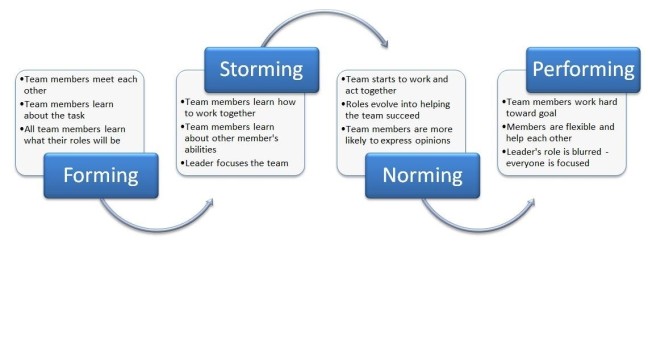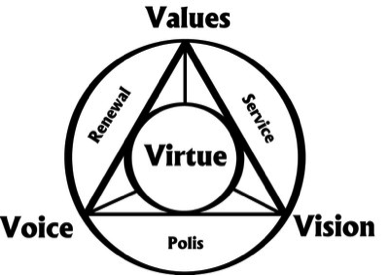
As I have already mentioned in my previous blogs, teams reflect their leaders as a mirror (Mullions 2010). The leadership style influences on the relations between the group and the organisation. A group leader gives guidance, help and support to the team, provides opportunities for team members, solves conflicts and pays attention to employee problems and decision making (Mullions 2010). It is very important, that a leader must establish a level of trust among the group and help them in understanding of the behaviours to build trust (McKenna and Maister 2002). McKenna and Maister (2002) argue that “The job of the group leader is to encourage people to earn the trust of others in their group and then show them how it can translate into greater commitment, greater creativity, greater professional satisfaction, and better performance”.
This blog shares my preferred style of leadership, type of leader I would like to be, leader who I am inspired by and my present feedback and strategies to improve for my future leadership.
In the previous blog 3 I considered “transformational leadership as one of the best leadership styles in business” (Zhambyl 2016). So, I would like to be a transformational leader and work with team members having capabilities to create and execute a guide vision of the needed change through inspiration and cooperation with team members. Under transformational leadership people have the opportunities for enhancing the motivation, morale, job performance. My dream is to become a role model for my team members and inspire them to become a team with great interest in the common projects.
Bass (1990) considered transformational leadership style in the framework of the leader’s influence on the team members due to his qualities. They trust, admire and respect for the leader, trying to work harder than usually. Transformational leaders give followers identity, providing with vision and inspiring mission, transform and motivate team through influence, intellectual stimulation and individual consideration (Bass 1990).
In order to become a transformational leader, four specific components are necessary. They are: idealized influence, inspirational motivation, individualized consideration and intellectual stimulation (Riggio 2009).
- Idealized influence – when the leader “serves as an ideal role model for followers”;
- Inspirational motivation – means the transformational leader’s charisma, constituting the inspire ability and the ability to motivate team members and people;
- Individualized consideration – means a great concern for the needs and feelings of his team and people, “personal attention to each follower” serves one of the important elements for achieving best results;
- Intellectual Stimulation – when the leader requires the team members to be “innovative and creative”, and challenges to “higher levels of performance” (Riggio 2009).
I am inspired by Steve Jobs, CEO, Chairman, and co-founder of Apple Incorporation. He had important “personal characteristics of a transformational leader: creative, passionate, and visionary” (Steinwart & Ziegler 2014). In his leadership, Steve Jobs had four above-mentioned elements of a transformational leader. Thus, he treated his team members equally, with a lot of flexibility; being a transformational leader, he concentrated on the “transforming others” in order to take care and help each other to imagine success and opportunities. He always knew the direction to lead the company and how to attract people with similar vision. Steve Jobs headed as an inspirational leader to his team and always knew what do people needed, so he experienced innovative technologies and applied them to the personal computer whereas nobody could even guess about it.
In the blog 3 (Zhambyl 2016) I shared the idea, that “best leader needs to combine different leadership styles and skills”. Steve Jobs, used also a participative leadership style in encouraging his followers to suggest new ideas and mentioned only “We” instead of “I” in his speech. Some people also considered him as a charismatic leader, who influenced people with the help of his speaking. Therefore, Apple was revitalized by Steve Jobs and the Apple Inc. developed a great number of new devices, such as the iPod, the iPhone,as well as iTunes and iPad.
Along with making computers revolution and technology accessible all around the world, once he said: “Technology is nothing. What’s important is that you have a faith in people, that they’re basically good and smart, and if you give them tools, they’ll do wonderful things with them”. This definitely explains the reason why a successful leader Steve Jobs is inspired by me and millions of people (Business News Daily 2016).
I do not consider myself as a leader yet. Vince Lombardi’s quote, which sucks me, is that “Leaders are made, they are not born. They are made by hard effort, which is the price which all of us must pay to achieve anything worthwhile” (Walter 2013).This statement is very powerful to me and shows something I must work towards. I believe that in order to be a successful leader I need to work and learn more. My lectures and seminars on “Leading in a changing world” taught me a lot about leadership theories, its styles and nature. The knowledge, I got due to this course, as well as literature review, allowed me analyzing my own abilities to become a leader, on the basis of different leadership models.
I have learnt, that organisations needs to “make use of the various strengths of employees” in order to survive and thrive (ACAS 2007). Belbin’s nine team roles model defines me as a “teamworker”,“co-operative, mild, perceptive and diplomatic”, having weakness to be easily influenced. (Mullins 2010).This is true, my strength is in close cooperation with other team members in a teamwork, with the use of perceptive and diplomatic way of suggesting new ideas, conviction and decision making. Buy I have to be more strong in some crunch situations and combine my present democratic style of leadership with transformational one (Mullins 2010) in order to become an effective leader in my business activity. I have also known a lot about ethical leadership, which includes such leader’s qualities as charismatic sociality, honesty, trust and fairness (Brown, Trevino,& Harrison 2005). I absolutely agree with the Nahavandi’s position (2009) that ethical leadership depends greatly on the cultural background of the leader. Moreover, working in a team, doing joint projects or presentations with groupmates, who came from different countries and represent various cultures, I began more familiar after learning about managing diverse teams, in understanding that only “full use of people’s individuality can bring mutual benefit of the group as a whole” (Mullins 2010).
Before my class on “Leading in a changing world” I had some difficulties in defining feedbacks for myself and colleagues. I have known the Situation-Behaviour-Impact model, which is very helpful for giving effective feedback. This model focuses on giving feedback on specific behavior situations and determines the impact of this person’s behavior on others (Wietzel 2000). Now I became more confident to give feedback to my colleagues and used to get constructive feedback, which made me more conscious about my strengths and weaknesses.
My colleagues recognised me as a very sociable and communicative person, able to work in a team, demonstrating reliability and confidence, but it is necessary to be more initiative in decision making. This feedback made me to be more brave and insistent in suggesting my own ideas to my colleagues, and decision making. For this purpose, I try to develop persistence, check my ideas, build self-confidence and potential improvements. And I do hope that MBA will provide me necessary skills to become more initiative in generating a vision in order to be an effective leader, to be able to inspire people for meeting challenges and to motivate people for better changes in organizations.
The course “Leading in a changing world” taught me to distinguish management and leadership. Now I understand, that management means “coordinating the activities of people and guiding their efforts towards the goals and objectives of the organization” (Mullins 2009), while leadership is “relationship through which one person influences the behaviour or actions of other people” (Zhambyl 2016).
I imagine to be a leader, who determines the goals and direction of the organisation, motivates and leads employees to achieve them (Zhambyl 2016). I am sure, that the knowledge I got from the leadership course, will allow me to “do right things” as a leader (Bennis 1989).
References
Bennis, W. (1989) On Becoming a Leader. New York: Addison Wesley
Bernard, M. (1990) Bass transactional to transformational leadership: Learning to share the vision, Organizational Dynamics, Vol. 18, , no. 3, Pp. 19-31.
Brown, M. (2005) Ethical leadership: A social learning perspective for construct development and testing’. Organizational behavior & human decision processes 97(2), 117-134
Business News Daily (2016) [online] available from http://www.businessnewsdaily.com/4195-business-profile-steve-jobs.html [8 March 2016]
Guirdham (2007) ACAS Teamwork: Success :Through People advisory booklet, M. Interactive Behaviour, p. 4 and p. 6.4
McKenna, P. & Maister, D. (2002) Building Team Trust’, Consulting to Management, vol. 13, no. pp. 51–3.
Mullins, J. (2010) Management and Organisational Behaviour. Pearson Publication.
Marlane C. (2014) Transformational Leader”: Implications for Pedagogy. Journal of Leadership Education, p. 52
Nahavandi, A. (2009) The Art and Science of Leadership. N.J.: Prentice Hall.
Riggio, R. (2009) Cutting-edge leadership, are you a transformational leader? [online] available from <https://www.psychologytoday.com/blog/cutting-edge-leadership/200903/are-you-transformational> [7 March 2016]
Walter, E. (2013) 5 Myths of Leadership [online] available from <http://www.forbes.com/sites/ekaterinawalter/2013/10/08/5-myths-of-leadership/#420038e6584b> [9 March 2016]
Wietzel (2000) Feedback that works: How to build and deliver your message. Centre for Creative Leadership
Zhambyl, A. (2016) Blog 3 Most effective leadership and management style [online] available from <https://wordpress.com/post/culczhambyla.wordpress.com/30> [7 March 2016]











